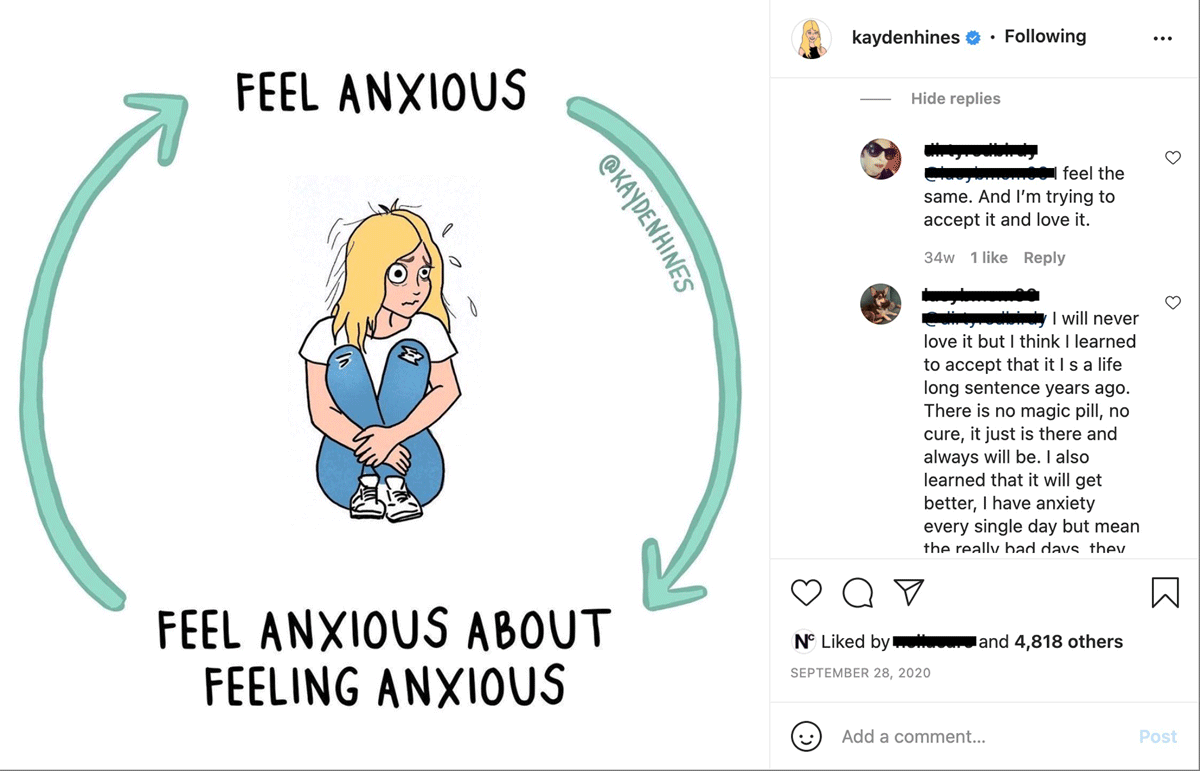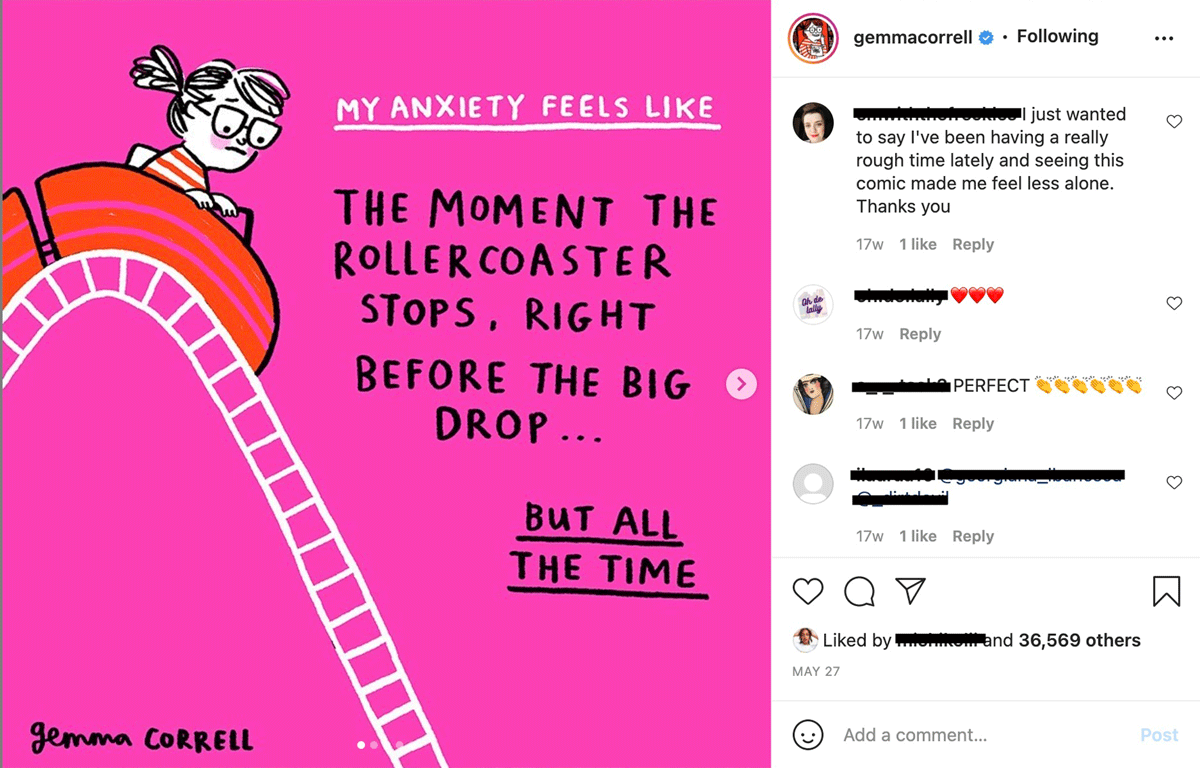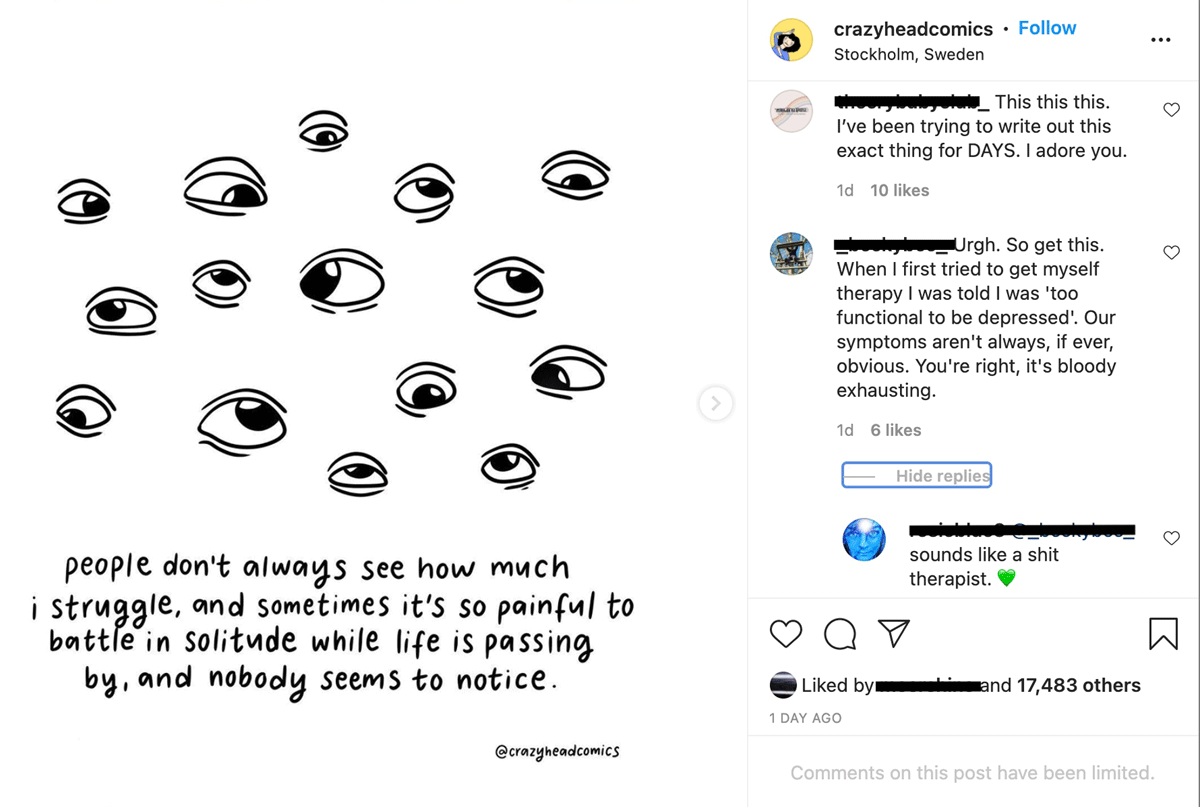The Covid-19 pandemic has caused a significant increase in mental health conditions and their associated symptoms (World Health 2021). Pandemic-necessitated isolation has rendered in-person treatment largely inaccessible, and the need for digital mental health resources has never been greater. For a variety of reasons, many individuals do not seek out professional mental healthcare, turning instead to popular culture as a means of therapeutic relief. There is something to be said for seeing yourself and your experiences replicated in print and/or online. In my experience, discussing my pandemic-related (and other) anxieties aloud does not bring the same sense of empowerment as does writing them down and making them tangible. Likewise, viewing an artist’s rendition of their experiences—whether similar to my own or not—provides evidence of shared understanding through similar and collective mental health trajectories. The mental illness comic is just that—hardcopy (and/or digital) proof that we are not alone in our navigations of mentally arduous events. Proof that others share our humorously self-deprecating, and oftentimes much more serious, mental health experiences.
A History of Representing Mental Illness in Comics
The tradition of representing mental illness in comics is not new. Foundational texts such as Chester Brown’s “My Mom was a Schizophrenic” (1998) set a precedent for shamelessly representing mental illness experiences. This biographical comic strip depicts Brown’s understanding of his mother’s mental illness while providing an example of how graphic narratives can portray the sensitive and personal experience of living with and/or witnessing the manifestation of a loved one’s psychiatric disorder. This seminal text, first published in the fourth installment of Brown’s “Underwater” series and later in his anthology, Little Man: Short Stories 1980–1995 (1998), also provides an example of how comics can duplicate the sensitive material of mental health-focused life writing and perhaps even exceed the possibilities of solely verbal narratives.
Following the lead of Brown and others (Justin Green and Binky Brown (2009), for example), are contemporary book-length graphic memoirs which detail the cartoonists’ experiences of fluctuating, and at times debilitating, mental illness. Ellen Forney’s Marbles: Mania, Depression, Michelangelo, and Me (2012), and Clem and Olivier Martini’s Bitter Medicine: A Graphic Memoir of Mental Illness (2010) are two such narratives. Told from varying perspectives, Marbles and Bitter Medicine share lived experiences of mental illness—not as anecdotal stereotypes or co-opted euphemisms—but as authentic recollections of the ways in which mental illness informs a person’s movement through normative spaces. To summarize briefly, Forney’s text serves as an autobiographical account of her fluctuating bipolar disorder symptoms. It provides a visual depiction of the cartoonist’s journey towards accepting her bipolar diagnosis by highlighting her accolades and accomplishments alongside, and not in spite of, her non-normative mental health (Forney 2012). In a slightly different vein, Martini and Martini’s narrative bridges the gaps between biography and autobiography by juxtaposing Clem’s prose narrative with schizophrenic brother Liv’s hand drawn comics. By juxtaposing comics and prose in a single text, the authors/artists use collaborative life writing (Couser 2004: xii, 28) to challenge the restrictions of both literary forms while highlighting the familial affects of Liv’s diagnosis. The narratives I have pointed to, I believe, loosely map the history of depicting mental illness in comics and showcase the variety of ways in which mental health can be represented in and across narrative mediums. This trajectory becomes increasingly exciting as comics begin taking on new, and at times, multimodal forms—i.e., when they begin showing up on social media and taking up more active roles.
Instagram Comics and Networked Publics
While digital comics and their virtual spaces of publication are not formal sites of mental healthcare, these web-based narratives—specifically those which appear on Instagram—often function as do-it-yourself networks of connection and support. I liken these to danah boyd’s definition of ‘networked publics’ (2011), best described for my purposes as the mental health communities which form on social networking platforms. Or, as I refer to them, the networks of graphic care. It is important to note that graphic care networks offer a unique communicative opportunity for individuals from various socioeconomic locations and identities: these networks offer users a platform for legitimizing their experiences (Thelandersson 2018), and perhaps more importantly, they are representative of both collective and individual mental health realities. Put differently, the cartoonists of Instagram are able to normalize their shared experiences of mental illness by employing their unique artistic styles as a means of demonstrating their personal realities. Likewise, the diverse group of users who engage with Instagram comics are able to, in a sense, pick and choose when and with which comics they relate to and see themselves in—at times relating to the narrative in its entirety and at times to one panel, one character, or one statement (McCloud 1994; Czerwiec et al. 2015).
With this in mind, I look to Instagram-based graphic narratives to explore how readers of mental health-related comics are using these texts to combat pandemic-related (and/or other) mental health deficiencies. The graphic mental health posts of Instagram I am interested in are (usually) single-panel or short sequence-comics which illustrate the cartoonist’s perspective of their own mental health. Instead of completing a detailed visual/discourse analysis of the mental health comics of social media—which would require a separate and much longer discussion—I focus the remainder of this essay on the conversations that develop in the comment section of three Instagram-based comics. By doing so, I hope to shed light on the ways in which readers of mental health-related comics are using ‘the comics scene’ of Instagram as a site for self and collective care.
The collection of Instagram comics I have included in this discussion have been posted within the last calendar year. While not explicitly related to Covid-19, the content in each represents feelings of anxiety and depression which, understandably, have increased significantly for many in response to the ongoing pandemic (World Health 2021). While the comics themselves are deserving of in-depth close analysis, in this discussion I am specifically interested in the comments that are generated in response to them. The comment threads of each posted comic indicate a shared interest in comics, of course, and perhaps even a shared interest in mental health-related content, but they also illuminate the ways in which social media users are engaging with each other and using ‘comment thread communities,’ so to speak, as virtual mental health resources, or, as noted above, as networks of graphic care.
In Kayden Hines’ (@kaydenhines) single panel comic from September 2020 (see Figure 1), social media users respond with remarks indicating that they have shared similar experiences of anxiety. Commenters offer their feelings in solidarity and note the complexities of living an anxious life. While some indicate that they are learning to “love” their anxiety, others explain that they are working towards accepting the fact that they will never be rid of it (see Figure 1). Similar responses are posted to a multi-panel comic shared on cartoonist Gemma Correll’s (@gemmacorrell) account. Posted in May of 2021, Correll’s hot pink panel background and rollercoaster imagery invites Instagram users to reflect upon how it ‘feels’ to feel anxious (see Figure 2). Similar to the responses to Hines’ anxiety comic, Instagram users post comments which indicate their shared understanding of, and appreciation for, Correll’s content. While mental illness has been depicted in comics for decades, the affordances of Instagram provide cartoonists’ accounts—and by extension, the graphic narratives they post—with the opportunity to serve as platforms for conversation, compassion, and community. Likewise, while the phenomenon of commenting on social media posts is not specific to mental illness comics, it is a new way of engaging with the comics medium. Instead of reading a print graphic narrative in solitude, social media users are able to like, reshare, comment, or, if they choose, simply continue scrolling.
A single-panel comic from @kaydenhines’ Instagram account. The right side of the image shows a portion of user comments, generated in response to the posted comic. Commenter Instagram handles have been blacked out to ensure user anonymity. Kayden Hines [@kaydenhines]. Posted September 28, 2020. © 2020 Kayden Hines.
A panel posted to Gemma Correll’s Instagram account. This image is part of a series of splash panels posted together, each with the prompt “my anxiety feels like.” The right side of the image shows a portion of user comments, generated in response to the posted comic. Commenter Instagram handles have been blacked out to ensure user anonymity. Gemma Correll [@gemmacorrell]. Posted May 27, 2021. © 2021 Gemma Correll.
Finally, the most recent post I have included, a series of panels shared by Matilda [no last name]’s @crazyheadcomics account (see Figure 3), portrays the isolating, and painful, experience of depression. The comments posted in response to this comic are particularly interesting because they indicate the beginnings of a comment chain between users. In this instance, commenters are not only responding to the comic itself, but to each other. The response which exclaims “sounds like a shit therapist” (see Figure 3) can be read in several ways: as a genuine note of support, a dig at the unnamed therapist, a somewhat humorous remark, or a combination of the three. Regardless of the intent, the thread of comments suggests that users are offering and looking to each other for mental illness solidarity. In other words, the comments shared in response to @crazyheadcomics’ post, and those which have been posted to the two abovementioned accounts, indicate that social media users are not only responding to web-based mental health comics as a way of showing their appreciation for the content. Rather, they highlight how these posts are being used as digital networks of support and comradery.
A panel posted to Matilda [no last name]’s Instagram account. This panel is part of a series of splash panels, each containing one large image and a narrative caption. The right side of the image shows a portion of user comments, generated in response to the posted comic. Commenter Instagram handles have been blacked out to ensure user anonymity. Matilda [@crazyheadcomics]. Posted September 28, 2021. © 2021 Matilda [no last name available].
Conclusion: Comics as Graphic Care
Examining the patterns of engagement with mental health and pandemic-related graphic texts is especially pertinent to the cultural moment we find ourselves in: a somewhat isolated, not-quite-post-Covid reality. If traditional, i.e., in-person spaces of mental healthcare and sociality are unavailable, perhaps virtual platforms and the comics posted to them might serve as a centre point for developing virtual communities based in self and collective care. Or, as I have labeled them twice now, the networks of graphic care. These networks bridge the gap between physical and virtual spaces of mental healthcare by allowing readers/social media users to form relationships based in mutual experience, regardless of the physical distance and/or socioeconomic differences between them. I use the term ‘relationship’ loosely here, as communication between users may involve a single exchange of comments, or a pattern of engagement across various posts. But perhaps a single exchange is, at times, enough to signal one’s solidarity.
Identifying the potential for Instagram-based comics to be recognized as accessible mental health communities is reflective of, and perhaps necessary for, our increasingly digitized world. In situations where care is limited by public health measures, means of access, and financial constraints, open-access resources which can be appreciated by a variety of demographics must be viewed as socially and therapeutically valid. Under the circumstances of a global pandemic, this notion seems readily apparent. However, perhaps it has been illuminated by the stressors of widespread hardship and will be equally crucial during more “normal” times. I do not mean to suggest that comics can stand in place of professional psychiatric care and/or other methods of coping with mental illness. Rather, I offer a new way of thinking about how we read and engage with graphic texts, and consider the ways in which comics may serve mental health communities more intentionally. This topic necessitates further investigation, but I end with the proposal that comics may be used as resources for coping with symptoms of mental illness both during, and speculatively beyond, the Covid-19 pandemic.
Author’s Note
Every effort has been made to trace copyright holders and to obtain their permission for the use of copyright material under educational fair use/dealing for the purpose and criticism and review and full attribution and copyright information has been provided in the captions.
Editors’ Note
This article is part of the Rapid Responses: Comics in and of The Moment Special Collection, edited by Jeanette D’Arcy and Kay Sohini, with Ernesto Priego and Peter Wilkins.
Competing Interests
The author has no competing interests to declare.
References
boyd, d 2011. “Social Network Sites as Networked Publics: Affordances, Dynamics, and Implications”. In Z. Papacharissi, ed. 2011. A Networked Self: Identity, Community and Culture on Social Network Sites. New York: Routledge. pp. 39–58.
Brown, C 1998. “My Mom was a Schizophrenic”. 1998. In The Little Man: Short Strips 1980–1995. Montreal: Drawn & Quarterly. pp. 162–68.
Correll, G 2021 @gemmacorrell anxiety roller coaster post. Available at: https://www.instagram.com/p/CPY6KkSL8y6/. [Last accessed 30 September 2021]
Couser, G. T 2004 Vulnerable Subjects: Ethics and Life Writing. Ithaca: Cornell University Press. DOI: http://doi.org/10.7591/9781501723551
Czerwiec, M. K., Williams, I., Squier, S. M., Green, M. J., Myers, K. R., & Smith, S. T (eds.) 2015 Graphic Medicine Manifesto. University Park: Pennsylvania State University Press.
Forney, E 2012 Marbles: Mania, Depression, Michelangelo, and Me. New York: Gotham Books.
Green, J 2009 Binky Brown Meets the Holy Virgin Mary. San Francisco: McSweeney’s Books.
Hines, K 2020 @kaydenhines anxiety cycle post. Available at: https://www.instagram.com/p/CFsVi9dg6Bf/. [Last accessed 30 September 2021]
Martini, C., & Martini, O 2010 Bitter Medicine: A Graphic Memoir of Mental Illness. Calgary: Freehand Books.
Matilda 2021 @crazyheadcomics depression post. Available at: https://www.instagram.com/p/CUXwXPOsh-a/. [Last accessed 30 September 2021]
McCloud, S 1994 Understanding Comics: The Invisible Art. New York: Harper Perennial.
Thelandersson, F 2018. “Social Media Sad Girls and the Normalization of Sad States of Being”. Capacious, 1(2): 1–21. DOI: http://doi.org/10.22387/CAP2017.9
World Health Organization 2021 @who post regarding mental health and Covid-19. Post no longer available. [Last accessed 19 February 2021]


